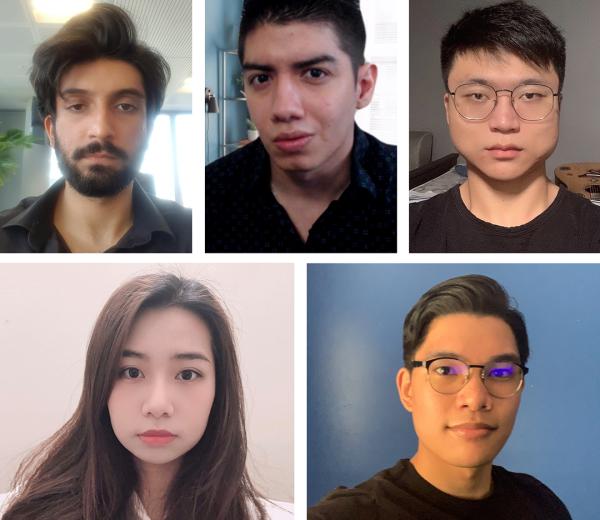
Four computer science undergraduate students and one graduate student took The City College of New York to third place in the Overhead Imagery Hackathon (OIH). The international competition entailed utilizing Artificial Intelligence and Machine Learning (AI/ML) methods to classify different types of building damage caused by natural disasters, such as hurricane, flood, earthquake and fire.
Dubbed CCNY + AFOSR to acknowledge the presence of the Air Force Office of Scientific Research’s Erik Blasch as an advisor, the team comprised graduate student Bilal Abdulrahman; and undergraduates Billy Davila, Shuoxin Liu, Ling Fang and Jed Magracia. It finished behind second place University of Wisconsin Madison and the winners, a combined University of British Columbia (Canada) + University of Mississippi Medical Center team.
Participants were presented with aerial images of disaster areas taken by aircraft or satellites and asked to survey the impact. “Instead of manually assessing the damage to come up with the most appropriate disaster relief plans, government agencies would like to exploit AI/ML techniques to effectively speed up the relief process,” said Jie Wei, CCNY computer science professor and the team’s co-advisor.
Zhigang Zhu, Herbert G. Kayser Professor of Computer Science, at City College who’s also on the faculty of the Computer Science PhD Program at the Graduate Center, CUNY, was the team’s other co-advisor.
Using cutting-edge deep learning techniques, the CCNY team was able to reduce the data and computational complexity in the analysis of the overhead images by order of magnitude.
According to Wei, they were, among other things, “able to develop two pix2pix Generative Adversarial Networks (GAN) with novel architectures to augment data with desired size and nature, a contrastive deep learning network that can learn from both pre- and post-disaster images, and a transfer learning network by use of information fusion that can transfer and fuse knowledge from larger data sets, resulting in a system dubbed CLIFGAN (Contrastive Learning Information Fusion GAN).”
The virtual hackathon was organized by the U.S. Air Force, Univ. of Wisconsin Madison and the Toyota Technological Institute at Chicago.
About the City College of New York
Since 1847, The City College of New York has provided a high-quality and affordable education to generations of New Yorkers in a wide variety of disciplines. CCNY embraces its position at the forefront of social change. It is ranked #1 by the Harvard-based Opportunity Insights out of 369 selective public colleges in the United States on the overall mobility index. This measure reflects both access and outcomes, representing the likelihood that a student at CCNY can move up two or more income quintiles. In addition, the Center for World University Rankings places CCNY in the top 1.8% of universities worldwide in terms of academic excellence. Labor analytics firm Emsi puts at $1.9 billion CCNY’s annual economic impact on the regional economy (5 boroughs and 5 adjacent counties) and quantifies the “for dollar” return on investment to students, taxpayers and society. At City College, more than 16,000 students pursue undergraduate and graduate degrees in eight schools and divisions, driven by significant funded research, creativity and scholarship. CCNY is as diverse, dynamic and visionary as New York City itself. View CCNY Media Kit.
Jay Mwamba
p: 212.650.7580
e:
jmwamba@ccny.cuny.edu